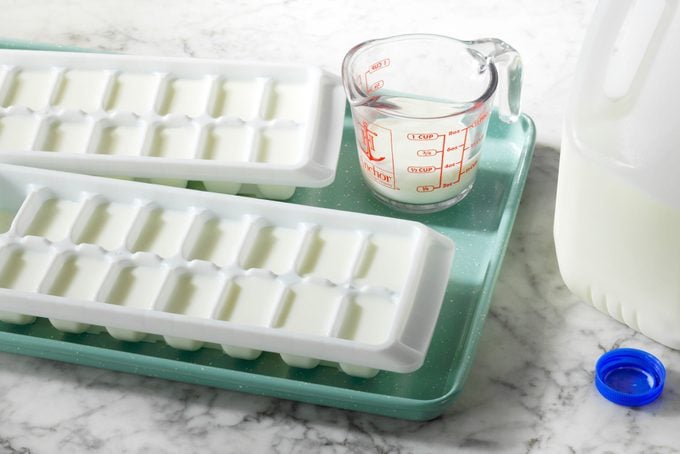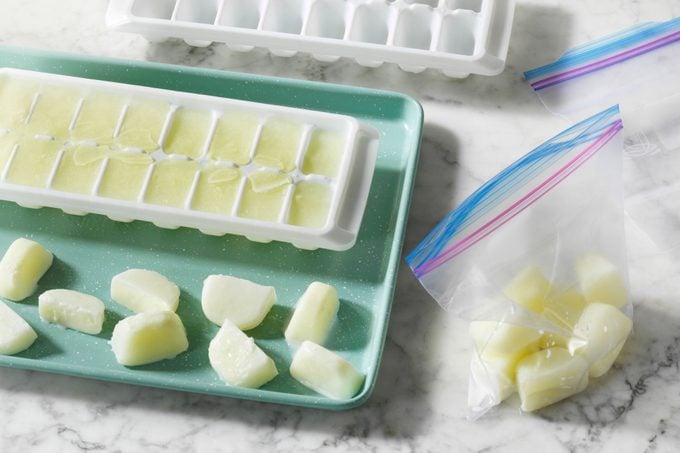Can You Freeze Milk?
Updated: Apr. 02, 2024
Don't waste another drop of dairy. We'll walk you through our best tips for how to freeze milk.
If you’re not drinking milk every day, the idea of finishing off a whole gallon, or even a whole pint, can be daunting. You don’t have much time, either—once it’s open, milk lasts only four to seven days past its use-by date.
Here’s the good news: You don’t have to pour your milk down the drain. Instead, freeze leftover milk to use later.
Can you freeze milk?

Yes! But freezing changes the texture of milk, so most people prefer to cook with thawed milk instead of drink it. Thawed milk works well in baked goods, like this hot milk cake, and even in the perfect chicken potpie.
How long can you freeze milk?
Milk will last for several months in the freezer, but for the best quality, use it within the first month. After that point, milk will begin to separate and turn grainy. You also don’t want to risk freezer burn.
How to Freeze Milk

The best way to freeze milk was recommended to us by a Taste of Home reader: Use ice cube trays! Pour milk into clean ice cube trays and freeze them. When they’re frozen, transfer the cubes to heavy-duty resealable plastic bags or freezer containers.
Two cubes in the average ice cube tray equals about 1/4 cup milk. This method will help you save freezer space, plus it lets you thaw the exact amount you need.
For larger portions of milk, invest in a 1-cup freezer tray that’s great for freezing soup and stock, too.
Tips for Freezing Milk
Freezing milk is simple, but take care to avoid a few pitfalls. Here’s how:
- Store milk in an airtight container. Milk is highly susceptible to picking up odors from other foods in the freezer. This can change the milk’s flavor once thawed. An airtight container will help keep out unwanted smells.
- Skip the carton. Use an ice cube tray or another container designed for the freezer.
- Leave 1 to 1-1/2 inches of headspace in the container. Liquid expands when it’s frozen. Having too much milk in the container can cause it to crack.
- Skim milk is more freezer-friendly than full-fat milk. Milk with a higher fat content separates more readily when thawed.
For more tips and tricks, check out our complete guide to freezing food.
How to Thaw Frozen Milk
You can leave frozen milk in the fridge to thaw overnight.
If you’re running short on time and need to defrost frozen milk quickly, you have two options. The first is to submerge your frozen milk (in an airtight container) in a bowl of cold water placed in the fridge. It will take about an hour to defrost. Just make sure to change the water after 30 minutes or so.
The second, and fastest, option is to microwave frozen milk. Transfer the frozen milk to a microwave-safe container and microwave in 15-second intervals. Once the milk has thawed, it should be cooked immediately.
Don’t set frozen milk out on the counter. Since bacteria multiplies between 40-140°F, defrosting frozen milk on the counter puts the milk in a bacteria “danger zone” which can make it unsafe to ingest, according to the USDA.
After you’ve safely defrosted your milk, it’s likely that you’ll see some separation or graininess. Simply give it a vigorous shake before using.
Can you freeze nondairy milk?
For the most part, yes, you can freeze nondairy milk following the same steps you would for freezing dairy milk. Just note that freezing and defrosting these will make them separate and get slightly grainy, so only use defrosted nondairy milk for cooking purposes or in smoothies.
